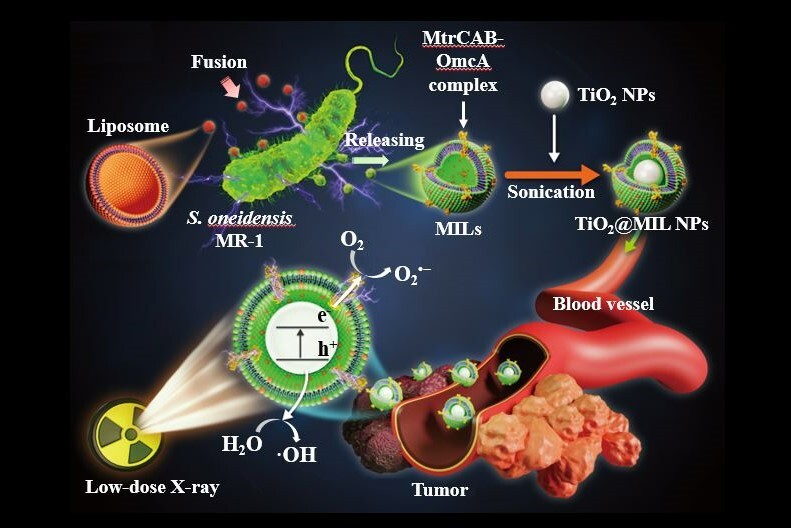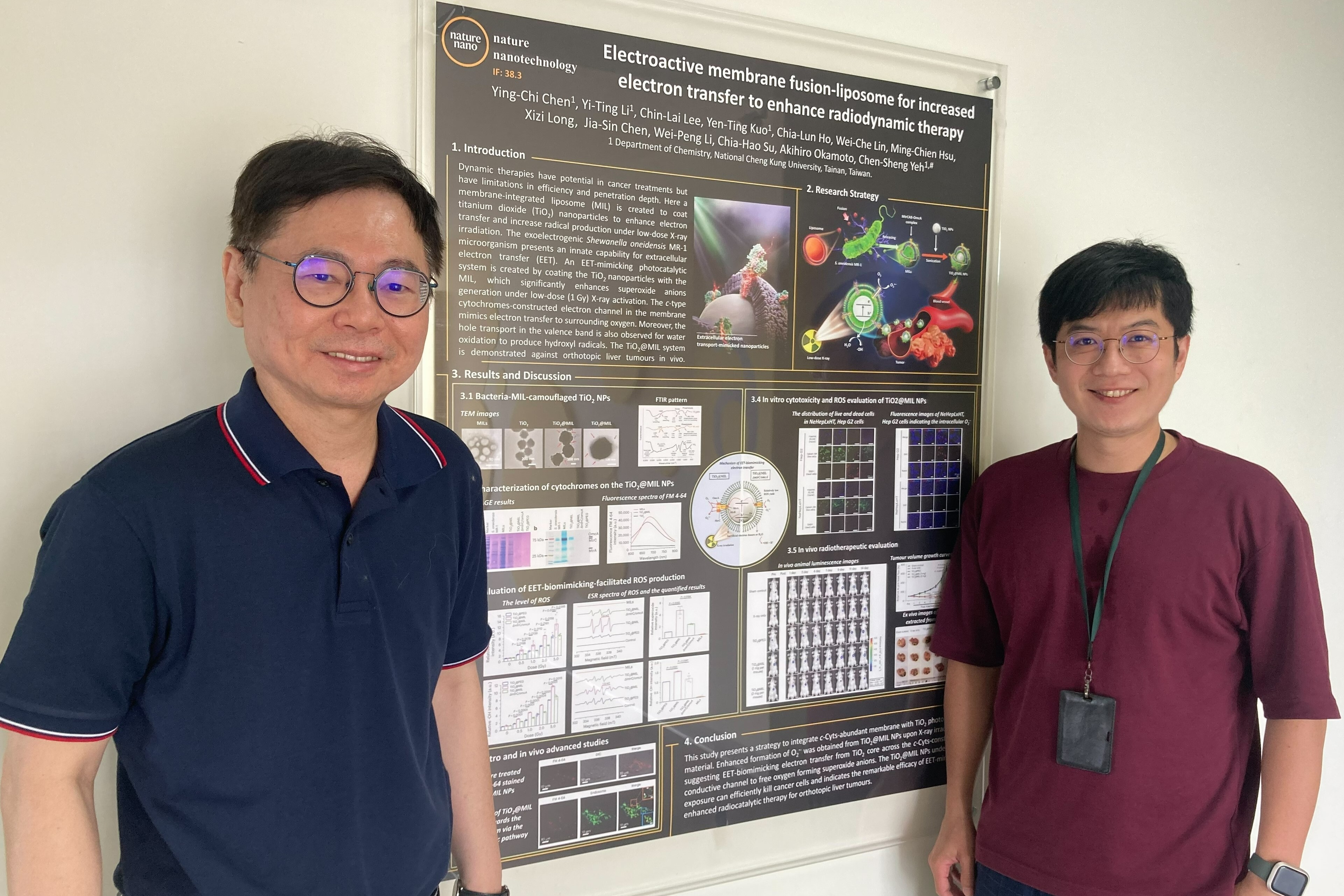NCKU Nanomedicine Milestone Research On Coated Bacteria To Suppress Cancer With Low-Dose Irradiation Published In Nature Nanotechnology
Written by Mingchun Wu. Image credit to Ying-Chi Chen

The TiO2@MIL system demonstrated against orthotopic liver tumors in vivo. (Image credit: Chen, YC. et al. 2023. Nat. Nanotechnol. https://doi.org/10.1038/s41565-023-01476-2)
A group of across national researchers, led by NCKU Professor Chen-Sheng Yeh (葉晨聖), explored the design and application of a membrane-integrated liposome (MIL) coated with titanium dioxide (TiO2) nanoparticles with low-dose X-Ray radiation for cancer treatment. Based on the in vivo orthotopic tumor model, the TiO2@MIL system is demonstrated radiotherapeutic effects. The result of “Electroactive membrane fusion-liposome for increased electron transfer to enhance radiodynamic therapy” was published in Nature Nanotechnology in August this year.
The TiO2@MIL research was initiated by Yeh, NCKU Department of Chemistry Chair Professor and Physical & Material Chemistry Nano-Odyssey Laboratory Deputy Director, with expertise in functional nanomaterial design and application. “Dynamic therapies have potential in cancer treatments but have limitations in efficiency and penetration depth,” noted Yeh. “Here a membrane-integrated liposome (MIL) is created to coat titanium dioxide (TiO2) nanoparticles to enhance electron transfer and increase radical production under low-dose X-ray irradiation.”
“The exoelectrogenic Shewanella oneidensis MR-1 microorganism, a harmless bacteria to human body featured with excellent electroactive property with protein channels for electron transport, presents an innate capability for extracellular electron transfer (EET). An EET-mimicking photocatalytic system is created by coating the TiO2 nanoparticles with the MIL, which significantly enhances superoxide anions generation under low-dose (1 Gy) X-ray activation. “

(Left to right) Shewanella picture by Alice Dohnalkova and Courtesy of Pacific Northwest National Laboratory. The illustrated mechanisms of the X-ray-induced EET biomimicking for electron transport from the TiO2@MIL system (Right image credit: Chen, YC. et al. 2023. Nat. Nanotechnol. https://doi.org/10.1038/s41565-023-01476-2)
“The c-type cytochromes-constructed electron channel, or referred as protein channels on nano-membrane for electron transport, in the membrane mimics electron transfer to surrounding oxygen. Moreover, the hole transport in the valence band is also observed for water oxidation to produce hydroxyl radicals. The TiO2@MIL system is demonstrated against orthotopic liver tumours in vivo.”
“The TiO2@MIL NPs under X-ray exposure can efficiently kill cancer cells and indicates the remarkable efficacy of EET-mimicked enhanced radiocatalytic therapy for orthotopic liver tumours. Opportunity to improve the efficiency and penetration depth of dynamic therapies for cancer treatment has been identified with this research,” noted Yeh. Compared with the potential harm to human tissues by high-dose X-ray (36 – 80 Gy) applied at the radiotherapy, the use of low dose at the minimum of 1 Gy would reduce the side effects, but significantly enhance the electron transfer from TiO2@MIL to generate superoxide anion and free radical. This will suppress cancer cells.

Professor Chen-Sheng Yeh and the first author Ying-Chi Chen
“We achieve to reduce TiO2 electron-hole recombination,” concluded Yeh, “to enhance electron transfer to achieve radiodynamic therapy using low dose X-ray exposure, as a milestone in nanomedicine research. We appreciate the peer support and resource sharing at NCKU, a cross national team work."
The first author Ying-Chi Chen (陳英齊) noted, “this research spanned two years and required a lot of time and effort to publish the results in Nature Nanotechnology. During this process, we are very grateful for the support from the professors at NCKU. The use of ESR (Electron Spin Resonance Spectrometer) at H. Teng Lab, approved by Professor Hsisheng Teng (鄧熙聖) of the Department of Chemical Engineering, demonstrated the generation of O2·− and ·OH upon X-ray irradiation in TiO2@MIL NPs. Parts of the fluorescence confocal microscopy images of cells, prepared at NCKU Bioimaging Core Facility managed by Professor Wen-Tai Chiu (邱文泰) from the Department of Biomedical Engineering, illustrated endocytosis as the primary pathway critical for trafficking of TiO2@MIL NPs towards the cytoplasm.” Chen is a Post Doctor researcher at NCKU Physical & Material Chemistry Nano Odyssey Laboratory.
This TiO2@MIL research was co-published with a group of cross national and discipline experts, including Japan National Institute for Materials Science The Research Center for Macromolecules and Biomaterials Professor Akihiro Okamoto (岡本章玄) who introduced the unharmful bacteria, and Taiwan Kaohsiung Medical University Department of Medicinal and Applied Chemistry Assistant Professor Wei-Peng Li (李偉鵬). The Taiwan Chang Gung University The Center for General Education and Kaohsiung Chang Gung Memorial Hospital Department of Radiation Oncology Professor Chia-Hao Su (蘇家豪) established the in vivo orthotopic tumour model to investigate the radiotherapeutic effect of TiO2@MIL.

(Left to Right) Chen-Sheng Yeh and the researcher team Akihiro Okamoto, Wei-Peng Li and Chia-Hao Su
Nature Nanotechnology is a monthly peer-reviewed scientific journal published by Nature Publishing Group. Nature Nanotechnology is an interdisciplinary journal that publishes papers of the high quality and significance in all areas of nanoscience and nanotechnology. The journal encourages the exchange of ideas between chemists, physicists, material scientists, biomedical researchers, engineers and other researchers who are active at the frontiers of this diverse and multidisciplinary field.
Provider:
NCKU News Center
Date:
2023-09-06




